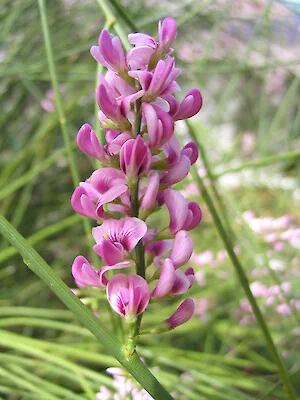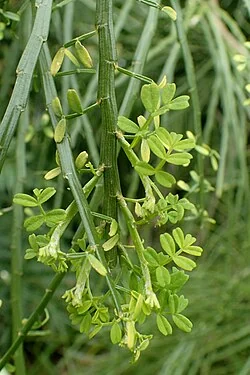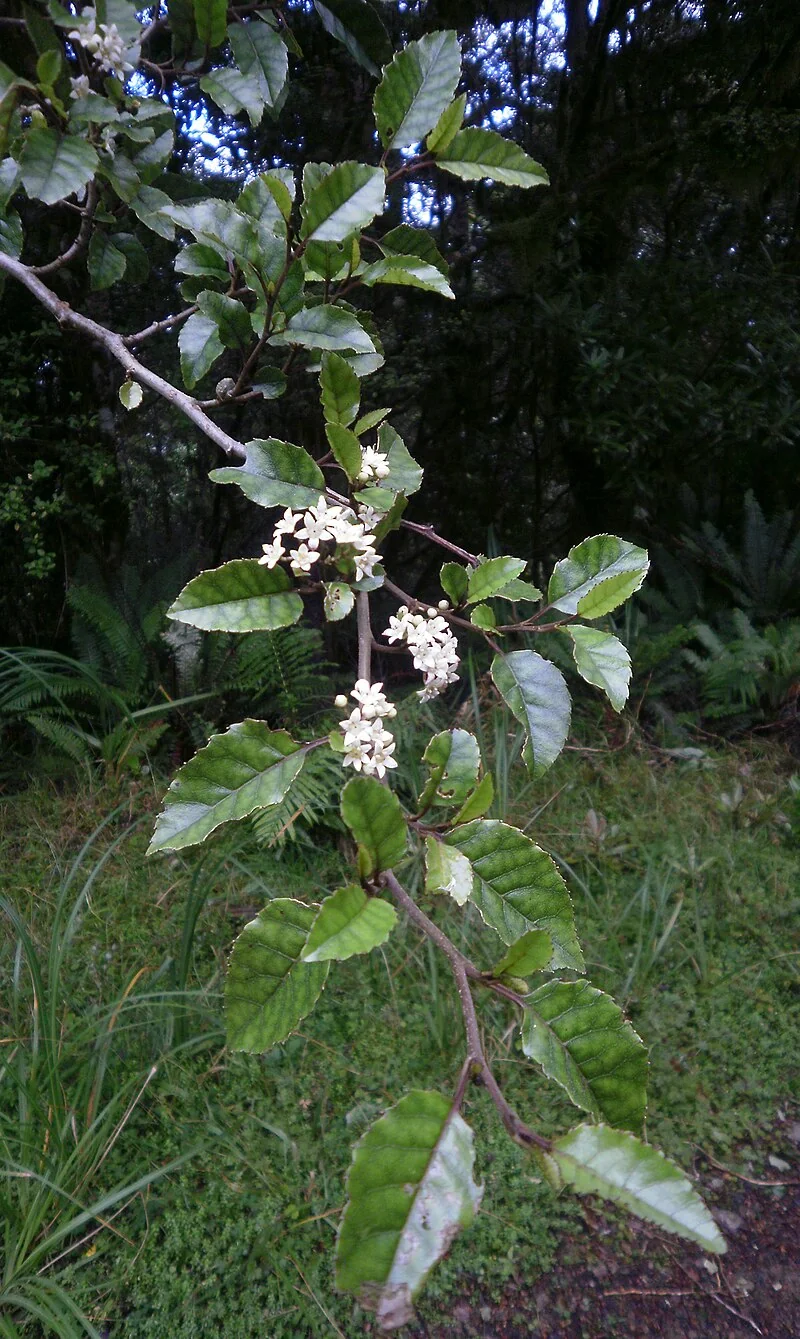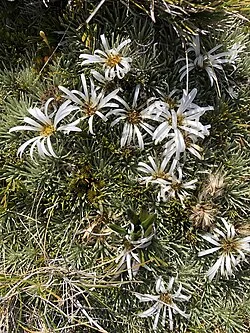
Corrugated Broom
Carmichaelia corrugata
Introduction
Overview
Corrugated Broom ( Carmichaelia corrugata ) is a unique leafless native shrub characterized by its distinctive grooved, photosynthetic stems that create an unusual architectural appearance. This remarkable adaptation allows the plant to photosynthesize through its green stems rather than traditional leaves, making it perfectly suited to dry, rocky environments. Endemic to New Zealand's Canterbury region and classified as At Risk - Declining, this species represents an important conservation priority while offering distinctive ornamental value for specialized native gardens.

Corrugated Broom is a distinctive, low-growing leafless shrub native to the dry river terraces and rocky slopes of New Zealand's South Island. It forms a dense, springy mat of grooved, yellow-green branches. In spring and summer, it produces small, pea-like pink flowers with attractive dark purple centres. This hardy plant is perfectly adapted to survive in poor, dry soils and is an excellent choice for rock gardens and other dry, sunny spots among New Zealand's native shrubs .
Quick Facts
| Scientific Name | Carmichaelia corrugata |
|---|---|
| Common Name | Corrugated Broom, Common Dwarf Broom |
| Family | Fabaceae |
| Height | 2-8 cm |
| Spread | Up to 1 m |
| Water Needs | Low, drought tolerant |
| Light | Full sun to partial shade |
| Frost Tolerance | Hardy |
| Salt Tolerance | Moderate; tolerates coastal conditions |
| Growth Rate | Moderate |
| Lifespan | Long |
Climate Best Suited to
White maire (Nestegis lanceolata) is primarily found in lowland to hilly forests across the North Island of New Zealand, extending to the Marlborough Sounds in the South Island. It demonstrates good adaptability to various conditions, thriving in areas with well-drained soils and tolerating both full sun and partial shade. Its natural distribution suggests a preference for warmer, more humid environments but with a reasonable tolerance for cooler temperatures found in its southern range.
Regional Suitability
| City | Climate Suitability |
|---|---|
| Whangārei | Ideal |
| Auckland | Ideal |
| Hamilton | Ideal |
| Tauranga | Ideal |
| Rotorua | Ideal |
| Gisborne | Ideal |
| New Plymouth | Ideal |
| Napier | Ideal |
| Whanganui | Ideal |
| Palmerston North | Ideal |
| Wellington | Ideal |
| Nelson | Ideal |
| Christchurch | Ideal |
| Dunedin | Moderate |
| Invercargill | Moderate |
Natural Habitat
Distribution and Environment
Understand the natural habitat of Corrugated Broom ( Carmichaelia corrugata ), including its geographical distribution, preferred environmental conditions, and the types of ecosystems where it thrives. This knowledge is crucial for replicating its natural growing conditions in cultivation.
- Geographical distribution in Canterbury and Central Otago.
- Preferred dry river terrace and rocky slope conditions.
- Typical associated plant communities in dryland ecosystems.
Plant Conservation
Carmichaelia corrugata, also known as common dwarf broom, is classified as "Threatened - Nationally Vulnerable" under the New Zealand Threat Classification System. This status was assigned in 2018 and reaffirmed in 2023.
Previously, the species was assessed as "Not Threatened" in 2004 and 2008, and then as "At Risk - Declining" in 2012. It is endemic to the South Island of New Zealand.
Growing Requirements
Soil Requirements
White maire (Nestegis lanceolata) is remarkably adaptable to different soil conditions, thriving in well-drained environments. It can tolerate a variety of soil types, from sandy to loamy, and prefers a neutral to slightly acidic pH. Good drainage is crucial to prevent root rot, ensuring healthy growth and development.
- Tolerates a wide range of soil types from clay to sandy
- Prefers well-draining soils but can handle occasional waterlogging
- Thrives in moderately fertile soils but will grow in poor soils too
- Can tolerate slightly acidic to slightly alkaline pH
- Handles coastal conditions including salt spray
Light Requirements
White maire (Nestegis lanceolata) thrives in a variety of light conditions, from full sun to partial shade. Optimal growth and flowering are typically achieved in locations receiving ample sunlight throughout the day. However, it can also tolerate some shade, especially in hotter climates, where it benefits from protection during the most intense afternoon sun.
- Full sun for optimal growth and form
- Can tolerate partial shade but may develop a leggier form
- At least 6 hours of direct sunlight daily is ideal
- Northern or eastern exposures work well in garden settings
Water Requirements
Once established, White maire (Nestegis lanceolata) is remarkably drought-tolerant, requiring minimal supplemental watering. During its establishment phase, consistent moisture is crucial to encourage strong root development. Mature plants can withstand dry periods, but regular watering during prolonged droughts will promote healthier growth and more abundant flowering.
- Moderate watering during establishment (first 1-2 years)
- Drought-tolerant once established
- Can handle periods of soil saturation
- Reduce watering in winter when growth slows
- Signs of overwatering include yellowing leaves and crown rot
Planting Guide
-
Best Time to Plant
Plant in spring or autumn to allow the plant to establish its root system during milder weather.
-
Choosing a Location
Choose a sunny, open site with very well-drained, poor soil. It is perfect for a rock garden, gravel garden, or a dry, sunny bank.
-
Planting Steps
Dig a hole that is no deeper than the root ball but twice as wide. Gently place the plant in the hole and backfill with the original soil. Water lightly. Do not add rich compost or fertilizer to the planting hole.
Ecological Role
Carmichaelia corrugata plays a vital ecological role in New Zealand's dryland and open shrubland ecosystems. As a nitrogen-fixing legume, it significantly contributes to soil fertility, making it a crucial pioneer species for stabilizing dry slopes and alluvial soils. Its unique branch architecture provides essential habitat and shelter for various native fauna, contributing to biodiversity and supporting complex food webs. The plant's resilience and ability to thrive in harsh conditions make it an important component of ecological restoration projects.
Uses and Significance
Garden Uses
- Specimen tree for visual impact
- Suitable for native gardens and restoration projects
- Enhances native garden aesthetics and biodiversity
- Provides architectural accent with its unique structure
- Effective for erosion control on slopes and banks
Ecological Value
Ecologically, White maire (Nestegis lanceolata) plays a crucial role in supporting native ecosystems. Its fruits are a food source for birds, especially the kereru, contributing to the local biodiversity and food web.
- Provides a vital food source for native birds, especially the kereru
- Offers habitat and nesting sites for various fauna
- Contributes to soil stabilization and nutrient cycling
- Forms natural shelter belts, protecting other species
Landscaping Applications
Design Integration
Discover how Corrugated Broom ( Carmichaelia corrugata ) can be effectively integrated into various landscaping designs. This section offers creative ideas and practical advice for using this unique dryland shrub to enhance the beauty and functionality of your outdoor spaces, from residential gardens to public parks.
- Design ideas for rock gardens and xerophytic landscapes.
- Best uses in gravel gardens and Mediterranean-style plantings.
- Combining with other dryland natives for aesthetic appeal.
Seasonal Care Calendar
Spring
In spring, White maire (Nestegis lanceolata) begins its active growth phase. New foliage emerges, and it's an ideal time for planting new specimens or propagating. Ensure adequate moisture and monitor for early signs of pests.
- New growth begins with fresh foliage development
- Apply a balanced, slow-release fertilizer if desired
- Excellent time for planting new specimens or dividing offsets
- Monitor for new pest activity and address promptly
Summer
Summer is the peak growing season for White maire (Nestegis lanceolata), often accompanied by flowering. Consistent watering is important, especially for young plants, to support vigorous growth and prevent stress during dry periods.
- Flowering typically occurs in early to mid-summer (November-January)
- Water young trees regularly during extended dry periods
- Avoid heavy pruning during the active growing season
Autumn
During autumn, White maire (Nestegis lanceolata) prepares for the cooler months. Fruits or berries develop, providing food for native birds. It's also a good time for planting and general garden cleanup.
- Fruits or berries develop and ripen (December-February), attracting birds
- Natural leaf shedding occurs as part of its growth cycle
- Good time for planting new specimens to establish before winter
- Clean up fallen leaves if a tidy appearance is desired
Winter
Winter is generally a dormant period for White maire (Nestegis lanceolata). Minimal care is required, though young plants may benefit from protection in colder regions. This is an opportune time for any necessary structural pruning.
- Generally dormant with minimal growth activity
- No special winter protection needed in most mild climates
- Suitable time for structural pruning if required
- Fallen leaves can be left as mulch or removed for tidiness
When to Prune and How Much
White maire (Nestegis lanceolata) generally requires minimal pruning to maintain its natural form and health. Pruning should focus on removing dead or damaged growth and shaping the plant as needed.
- Remove dead, damaged, or diseased branches at any time of year
- Light formative pruning when young helps establish good structure
- To create a multi-trunked specimen, cut the main stem to encourage branching
- Fallen leaves can be removed for a tidier appearance, or left as natural mulch
- If necessary, lower branches can be removed to create clearance underneath
- Major pruning is best done in late winter to early spring before new growth
Always use clean, sharp tools for pruning to minimize the risk of disease and ensure clean cuts. The plant often responds well to pruning with vigorous new growth, contributing to a fuller, healthier appearance.
How to Grow Corrugated Broom
From Seed
Corrugated Broom ( Carmichaelia corrugata ) is most reliably raised from seed. Collect ripe pods in late summer to autumn; the small, hard seeds are typical of New Zealand brooms (Fabaceae) and benefit from scarification to improve water uptake. Either nick the seed coat gently with a file, or pour hot (not boiling) water (~80°C) over the seeds and leave to soak for 12-24 hours until swollen. Sow into a very free-draining seed-raising mix and cover lightly (2-3 mm). Maintain bright light, excellent airflow and temperatures of 15-22°C; keep the medium evenly moist but never wet. Germination generally begins within 2-6 weeks but can be staggered. Prick out seedlings promptly into individual tubes to protect the developing taproot. Because Carmichaelia species form nitrogen-fixing symbioses, using a native-friendly mix or incorporating a small amount of local soil can help early rhizobia nodulation and vigorous growth. Harden off gradually and plant out in full sun with very sharp drainage: conditions that mirror the speciesâ natural dry river terraces and stony ground in eastern South Island regions.
From Semi-Hardwood Cuttings
Cutting propagation is feasible but slower and with lower strike rates than seed. Take firm semi-hardwood cuttings 6-8 cm long from healthy current-season shoots in late spring to late summer. Reduce any small side shoots at the base, retain a minimal tuft at the tip, and make a clean basal cut just below a node. Dip bases in a rooting hormone (IBA 0.3-0.8%) and insert into a very free-draining medium such as 1:1 perlite and coarse sand. Provide bottom heat around 18-22°C and high humidity without prolonged leaf wetness; good ventilation is important for this leafless, cladode-bearing genus to limit fungal issues. Keep the medium just moist. Rooting can take 8-12+ weeks; pot on carefully into a gritty, well-drained mix and harden off in bright light. Establish outdoors only into full-sun, free-draining sites: overwatering or poorly drained soils are the most common causes of losses.
Pests and Diseases
Corrugated Broom ( Carmichaelia corrugata ) is generally a very hardy plant with excellent natural resistance to most pests and diseases, adapted to survive in challenging conditions.
Common Pests
- Browsing animals: Rabbits and hares can damage plants in the wild
- Generally pest-free: Most garden pests avoid this tough, low-growing plant
Common Diseases
- Root rot: The main threat, caused by excessive moisture and poor drainage
- Fungal issues: Rare, but can occur in humid conditions with poor air circulation
Environmental Stressors
- Overwatering: Can be fatal, especially in winter
- Poor drainage: The most common cause of plant failure
The key to success with Corrugated Broom is providing excellent drainage and avoiding overwatering. Once established in suitable conditions, it is extremely resilient.
Cultural Significance
Corrugated Broom (Carmichaelia corrugata) was used by Māori for various purposes. The tough, flexible stems were used for weaving and construction, and the plant also had medicinal uses in rongoā (traditional Māori medicine).
Bonus Tip
Nitrogen Fixation and Ecological Benefits
Like many legumes, Corrugated Broom is a nitrogen-fixing plant. This means it has a symbiotic relationship with bacteria in its root nodules that convert atmospheric nitrogen into a form usable by plants. This natural process enriches the soil, making it a valuable pioneer species for improving soil fertility in degraded or poor soils, and an excellent choice for ecological restoration projects.







